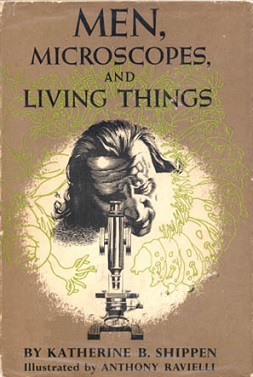Men, Microscopes, and Living Things facts for kids

First edition
|
|
| Author | Katherine Shippen |
|---|---|
| Illustrator | Anthony Ravielli |
| Country | United States |
| Language | English |
| Genre | Children's literature |
| Publisher | Viking Press |
|
Publication date
|
1955 |
| Media type | Print (Hardback & Paperback) |
| Pages | 190 pp |
Men, Microscopes, and Living Things is an exciting children's book written by the American author Katherine Binney Shippen and illustrated by Anthony Ravielli. It was first published in 1955. This book was recognized as a Newbery Honor book in 1956, which is a special award for great children's literature.
Contents
Exploring the World of Life
This book takes young readers on a journey through the history of how people have understood living things. It explores the ideas of many important thinkers and scientists over time. The book is 190 pages long and includes a helpful index.
Early Ideas About Life
The story begins with ancient thinkers like Aristotle, who lived a very long time ago in Greece. Aristotle was one of the first to carefully observe and classify animals. He tried to understand how living things were connected.
Later, Pliny from ancient Rome wrote a huge book called Natural History. This book collected almost everything known about the natural world at the time. It was a major source of information for centuries.
Classifying Living Things
The book then introduces scientists who helped organize the vast number of living things. One key person was Carl Linnaeus. He created the system we still use today to name and group plants and animals. His system gives every living thing a two-part scientific name, like Homo sapiens for humans.
Understanding Change Over Time
The book also looks at how scientists started to think about how life changes. Georges Cuvier was a French scientist who studied fossils. He showed that some animals had gone extinct, meaning they no longer existed on Earth.
Lamarck had ideas about how living things changed over generations. He believed that animals could pass on traits they developed during their lives to their offspring. For example, if a giraffe stretched its neck to reach leaves, its babies would have longer necks. While his specific ideas weren't quite right, he was important for thinking about evolution.
The Theory of Evolution
One of the most famous scientists in the book is Charles Darwin. He developed the theory of evolution by natural selection. Darwin's idea was that living things change slowly over very long periods. Those with traits that help them survive and reproduce in their environment are more likely to pass those traits on. This leads to new species over time.
The book explores these and many other scientists who helped us understand the amazing world of living things, from tiny microbes seen through microscopes to the largest animals on Earth.

